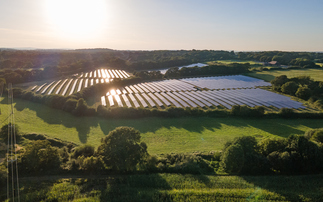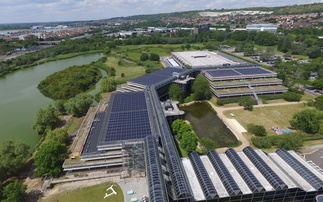Microinverter company believes technology can compete on its own merits and says falling costs will continue to drive growth in traditional markets
Solar can't survive without subsidies, critics say. Take away government funding and the industry is no more. But according to Paul Nahi, chief executive of Enphase Energy, which supplies microinverters to solar systems, nothing could be further from the truth and, in fact, it is traditional energy supplies that benefit the most from government support.
"It's a little bit challenging when people tell me solar is subsidised. It is, but we're not subsidised to anywhere near the degree traditional fossil fuels are," he says, citing the $544bn of subsidies the International Energy Agency calculates traditional fuels received in 2012 - more than five times the $101bn given to green energy. "Subsidies should be a catalyst not a crutch. I would very much be in favour of an environment that had no subsidies - not for solar, not for wind, and not for fossil fuels," Nahi adds. "Let us compete in the marketplace."
Nahi argues that in many parts of the world declining costs of solar modules and rising price of fossil energy ensure solar is already competing with conventional fuels and subsidies simply distort the market. The fact that subsidies vary across territories - and are constantly at risk of change - make basing a business model on support highly uncertain.
However, Nahi is in favour of charging polluters who currently dump emissions into the atmosphere for free as a means of leveling the playing field between mature and emerging energy technologies.
"If we were to do nothing but get rid of the subsidies solar would be competitive - in fact solar would be more competitive than fossil fuels today," he says. "But what would end up happening is that the cost of fossil fuels would rise. The 'net' is a more productive environment for solar - and it would allow us to compete by receiving the appropriate market signals."
California-based Enphase has negotiated the choppy waters of the solar market since 2008 - a period which has seen subsidy levels fluctuate, while periods of relative stability have been punctuated by tit-for-tat trade investigations between the EU, China, and the US over 'dumping' of cheap panels and government subsidies. A complaint to the World Trade Organisation (WTO) over Canada's preferential subsidy rates for domestic producers saw the policy revoked and Enphase close a formerly successful manufacturing facility in the country as a result.
Last year, the company reached a milestone by shipping its five millionth micro-inverter. The devices connect to solar panels, maximising energy production to help the system reach pay back quicker and converting DC power into low-voltage AC electricity. The company's associated Enlighten system allows customers to monitor performance on a monthly, daily, or hourly basis, analyse output against historic weather data and, as is the trend these days, share this information through Facebook or Twitter. Over 100,000 reporting systems have confirmed that the technology has tracked the generation of more than 1TWh of clean electricity to date.
Its success has seen Enphase expand into 11 countries, opening offices in the UK and France to serve Europe and the Middle East, while a new office recently opened in Australia. Enphase was acknowledged as the fastest growing clean tech company in North America on Deloitte's 2013 Technology Fast 500 - and the 14th fastest growing company across all sectors.
Enphase introduced its fourth generation microinverter in July last year, boosting efficiency and cutting the cost compared to the previous product, and a now fifth generation version is set to follow in 2015.
The company has targeted rooftop systems - both commercial and residential - as its primary market, and while Nahi says products suitable for utility scale solar developments are in the pipeline, he expects to see continued growth in the rooftop sector. Moreover, he believes emerging markets with large off-grid populations will provide growth, while for the next three years he also expects solar to strengthen its position in its traditional strongholds. "What we're seeing in Europe is a trend towards self-consumption - generate what you use - which in many cases means a smaller system," he says. "Smaller systems don't work well with string inverters - they are perfect for micro-inverters. If you look at the large urban, first world countries you're going to see a tremendous growth in solar in the next few years. The dynamics that are making solar popular are just getting better. The cost is coming down, the cost of fossil fuels is continuing to go up and solar as an asset class is being recognised by the financial community so the cost of capital to finance solar is coming down continuously."
There is plenty of evidence to back up Nahi's bullish predictions. The past year has seen multi-million solar investment funds launched by companies including Foresight, Bluefield, NextEnergy Renewables Infrastructure Group. While the bulk of these investors are targeted at solar parks, Nahi reckons institutional investors are increasingly interested in the rooftop sector. "It's being recognised as a secure and stable asset," he explains. "Today you can buy a solar system and get a loan so there's no money out of pocket and the cost of the debt service is less than you would have paid for the electricity generated. No money down and cashflow positive from day one - those are the dynamics driving solar. It's great for the consumer and now investors can also appreciate that return."
Moreover, this self-generation model starts to threaten utilities, most especially the monopolistic US suppliers. But Nahi believe utilities will still have a major role to play in terms of driving investment in solar and must not be allowed to become relics. "It's very important the solar industry plays well with the utilities," he says. "We need them, we want them to be strong and healthy, and we want to make sure our business models are fully aligned. But the days of that traditional monopoly are numbered."
Nahi is optimistic that growing numbers of utilities have realised that they need to adapt to this brave new world. "There are utilities that are investing heavily in solar and becoming comfortable with that," he says. "Generally it's utility scale so it resembles a coal- or gas-fired power plant, but those same companies are investing in financial vehicles that are supporting distributed energy as well. Utilities are modifying their business models to incorporate third party ownership and to engage in that ownership themselves."
Utilities entering the solar market in a big way would be a huge boost for Enphase, which expects to ship between two and two and a half million microinverters this year. But other potential markets are also opening up for the company. "We're not Enphase Solar - we are Enphase Energy for a reason," Nahi says. "So we look at energy from the viewpoint of generation, but also storage, load management, even things like co-generation."
Finding other applications for the technology will be crucial if, as predicted, falling costs continue to put pressure on margins for solar specialists. But Enphase seems well positioned to cope, regardless of what happens to solar subsidies in the future.









